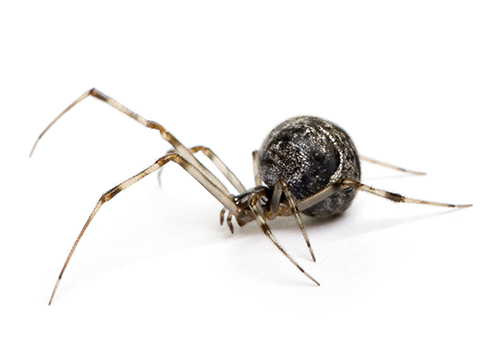Spiders spin possible solution to 'sticky' problems

This spider is an Achaearanea tepidariorum.
The Akron scientists created synthetic duplicates of the super-sticky, silk “attachment discs” that spiders use to attach their webs to surfaces. These discs are created when spiders pin down an underlying thread of silk with additional threads, like stiches or staples, explains Ali Dhinojwala, UA’s H.A. Morton professor of polymer science and lead researcher on the project.
This “staple-pin” geometry of the attachment disc creates a strong attachment force using little material, he adds.
Through electrospinning, a process by which an electrical charge is used to draw very fine fibers from a liquid (in this case, polyurethane), Dhinojwala and his team were able to mimic the efficient staple-pin design, pinning down an underlying nylon thread with the electrospun fibers.
“This adhesive architecture holds promise for potential applications in the area of adhesion science, particularly in the field of biomedicine where the cost of the materials is a significant constraint,” the authors write in their paper, “Synthetic Adhesive Attachment Discs Inspired by Spider’s Pyriform Silk Architecture,” published online March 1 in the Journal of Polymer Physics.
Dhinojwala adds that the design could potentially be used, in addition to medical applications, to create commercial adhesives stronger than conventional glue and tape.
“Instead of using big globs of glue, for example, we can use this unique and efficient design of threads pinning down a fiber,” he says. “The inspiration was right in front of us, in nature.”
“You can learn a lot of science from nature,” adds Dharamdeep Jain, a graduate student and co-author of the paper.
Indeed, researchers at UA have been learning quite a bit from nature’s silk-spinning artists.
Dhinojwala and Vasav Sahni, former graduate student and third co-author of the aforementioned paper, previously worked together to study the adhesive properties of spider silk; and last year Todd Blackledge, Leuchtag Endowed Chair and associate professor of biology and integrated bioscience at UA, revealed the possibilities of using silk to develop materials that are as strong as steel and yet flexible as rubber.
Story by Nicholas Nussen
Media contact: Denise Henry, 330-972-6477 or henryd@uakron.edu.
Media Contact
All latest news from the category: Materials Sciences
Materials management deals with the research, development, manufacturing and processing of raw and industrial materials. Key aspects here are biological and medical issues, which play an increasingly important role in this field.
innovations-report offers in-depth articles related to the development and application of materials and the structure and properties of new materials.
Newest articles

A universal framework for spatial biology
SpatialData is a freely accessible tool to unify and integrate data from different omics technologies accounting for spatial information, which can provide holistic insights into health and disease. Biological processes…

How complex biological processes arise
A $20 million grant from the U.S. National Science Foundation (NSF) will support the establishment and operation of the National Synthesis Center for Emergence in the Molecular and Cellular Sciences (NCEMS) at…

Airborne single-photon lidar system achieves high-resolution 3D imaging
Compact, low-power system opens doors for photon-efficient drone and satellite-based environmental monitoring and mapping. Researchers have developed a compact and lightweight single-photon airborne lidar system that can acquire high-resolution 3D…





















